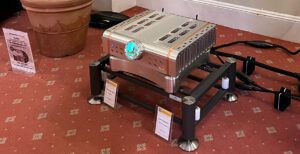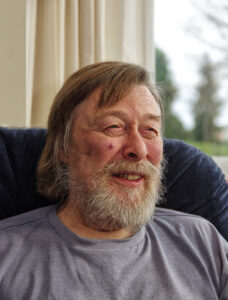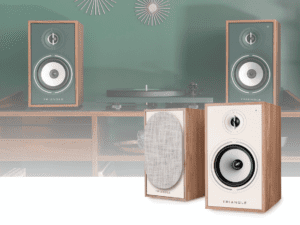
Although most now associate the name with the Chariots of Fire and Blade Runner soundtracks and the score for Carl Sagan’s epic Cosmos TV series, Vangelis’ career as a composer, musician and producer spans more than half a century.
Vangelis shuns publicity and rarely gives interviews. We are therefore truly honoured to get a few words from the Greek aster, during the recent launch of his remastered solo album series.
RC: How did the remastering project come about?
V: When the technology of today gives the opportunity to achieve a better quality without changing the sound, it becomes a must. For a long time, I have felt the need, if you will, to remaster my albums, and finally the record company has more recently agreed.
RC: What were your goals when you started remastering your work? What kind of alterations did you want to make?
V: The least amount of alteration as I could, because I believe the sound of the original recording must be preserved as much as possible. That which I try to achieve is, as I mentioned for the previous question, a better quality with a fuller sound that is more in focus, but without changing the original character.
RC: SACD and other surround formats would seem ideal for your music, which has so many layers of sound. What could be done with surround sound that perhaps has not been done so far?
V: For this to happen, every piece of music would need to be re-mixed from scratch using today’s surround sound system. I agree with you that this approach is very interesting, and it is something different than what was required, but it may be a possibility in the future.
RC: Listening to your earlier recordings, such as L’Apocalypse des Animaux, it is clear you were using the Hammond effectively as a synthesizer. How did you create such a range of sounds from this instrument and the other keyboards available at the time?
V: When I recorded L’Apocalypse des Animaux, I used the Hammond organ, as there was hardly anything else, and I tried to extract various and different sounds by pushing this instrument to its limits – something I continue to do today with all the different synthesizers I use.
RC: Your mastery of the Yamaha CS80 is well known. What is it about this instrument that allowed you to make such expressive use of it?
In the middle of the 1970s, Yamaha made a synthesizer that, for the first time, offered to the user the ability to perform, because of a very successful approach to ‘playability’ in relation to other synthesizers. This very successful technological achievement, unfortunately, was not continued, perhaps because it demands a certain level of knowledge of performing technique, and for this reason, it may have been considered a difficult synthesizer and not easy to sell.
If, however, this approach had been continued and improved upon, then maybe music today would have been more natural and more interesting, instead of ending up with awkward and difficult to use boxes that do not offer anything other than a library of sounds.
RC: When was the last time that a new instrument excited you with its possibilities?
Although many of today’s synths offer improvements in sound quality, for playability and expression there have been none.
RC: What role do sequencers play in your recording process, and how did you go about designing unique devices such as Direct?

RC: How would you like synthesizers to progress in the future?
A synthesizer needs to be built (as the technology already exists) to achieve playability analogous to traditional instruments, and not to be reduced to boxes that are simply libraries.
RC: What advice would you give young composers trying to navigate the music industry, especially those tempted to rely on technology?
The electronic approach to music leads, most of the time, down an awkward path, not due to the technology itself, but due to the uncomfortable and sometimes puzzling way of synthesizer design, which often neglects the human factor. Ideally, technology should be a help to young musicians and not a burden, just as the music industry should support creativeness and not only be a profit-oriented exercise.
Vangelis: The Discography
 A back catalogue encompassing more than 40 years and split over several labels is bound to create a few headaches. Full credit is due then to Esoteric Records for obtaining the rights to Vangelis’ RCA and Arista albums.
A back catalogue encompassing more than 40 years and split over several labels is bound to create a few headaches. Full credit is due then to Esoteric Records for obtaining the rights to Vangelis’ RCA and Arista albums.
This is a notable collection as it pre-dates, and then follows, Vangelis’ years with Polydor Records. In the 1970s, Vangelis tended to be lumped in with keyboard wizards Keith Emerson and Rick Wakeman, but a close listen to the music reveals more of a kinship with musicians like Stevie Wonder and Count Basie.
The supergroup Yes briefly considered Vangelis as a replacement for Wakeman, and the press coverage helped build anticipation for Heaven and Hell. The first album recorded in his London studio, Nemo, this 1975 release was a tour de force with layered keyboards, thundering percussion and ethereal vocals from Jon Anderson and the English Chamber Choir, while next LP, Albedo 0.39, which had a much harder rock element than anything Vangelis had released since his work with Aphrodite’s Child.
Spiral (1977) brought in the Yamaha CS80, one of the first polyphonic synthesizers. This album revealed more of Vangelis’ skill as an arranger, particularly on ‘Ballad’, where a wordless vocal (altered by a chorus effects unit) is underscored by synthesized strings and blues harmonica.
The final RCA album, Beaubourg, proved controversial. A solo piece for CS80, this ring-modulated improvisation was sonic interpretation of Richard Rogers’ Pompidou Centre, located in the Beaubourg area in Paris.
The two albums later released on Arista, Direct (1988) and Page of Life (1991), benefited from advances in sequencer and sampling technology throughout the 80s. Page… was the final Jon and Vangelis collaboration.
The design and packaging of the CDs is superb and reflects Esoteric’s ‘by fans, for fans’ commitment to reissues. While the ‘enhanced’ sonics (occasional boosted highs and additional reverb) might not be everyone’s cup of salepi, the remasters provide a fresh look at some of the best loved and most significant examples of Vangelis’ singular talent.
Tags: FEATURED
Read Next From Blog
See all
Audio Show Deluxe 2024: A photo show report
- Mar 28, 2024

Paul Messenger 1949-2024: A personal tribute
- Mar 26, 2024

Bristol Hi-Fi Show 2024: See You There!
- Feb 21, 2024

Triangle Borea Connect
- Feb 19, 2024










